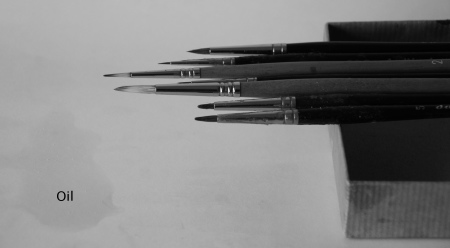Storing Brushes in Linseed Oil
February 11th, 2009
various brushes stored in linseed oil
. . . have a plate of tin or lead which is one finger deep all around, like a lamp; and keep it half full of oil, and keep your brushes in it when idle, so that they will not dry up.
–Cennino Cennini, 14th century
I use a plastic painting tray from the hardware store, which has the advantage over the dish Cennino describes in that the brush handles remain clean because they are not submerged. I’ve seen a painting from the 15th century that shows the same design as depicted in the photo above, but with wood replacing plastic. At the top left of the tray I attached a dowel (a pencil) with sculpting wax on it for the brushes to rest on so that they don’t slide down and resting against the bottom. I keep the whole tray in a light-proof box to keep it clean and reduce the drying of the oil inside.
I am storing about thirty-five brushes in this tray. Red sables with short (or rather, normal) handles are at the lower layer, resting directly on the pencil with the wax. These brushes are not visible in the photo. On top of these I put longer-handled brushes, some with fine red sable hair, others with synthetic hair. There are also hogs’ bristle brushes. These are stiffer than the others, and I let them rest against the bottom of the tray.
When I want to paint, I take the brushes I want from the oil tray and prop them up on some palette paper for a few minutes while I am getting ready (setting out the palette, etc…) The point here is to let gravity draw the excess oil off the brush and onto the palette paper. This is a nice way to start the day: grab a handful of brushes and do this with them: there is a process here, action, a beginning, and it’s easy to set in motion . . .

letting excess oil drain from the brushes
When I’m ready to begin painting, I wipe the brushes clean with a paper towel so that the wood is “dry,” not oily to hold, and there is only a thin film of oil around the brush hairs (they are slightly “damp” but not “wet” with oil). Then I put the brushes on a box, like this:

brushes ready to be used
The drained oil (clean, mind you) remains on the palette paper, where I can use it later for cleaning the brushes.